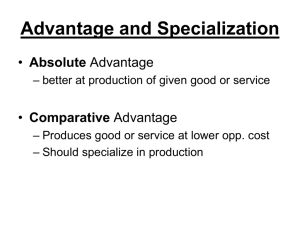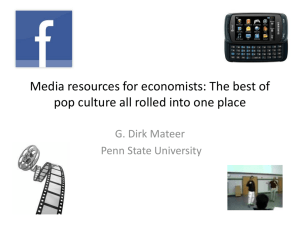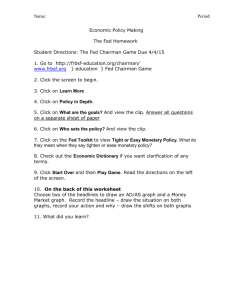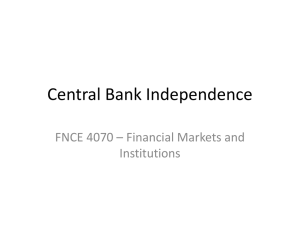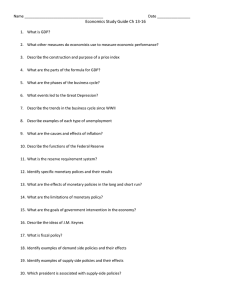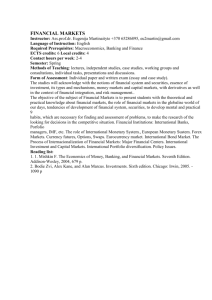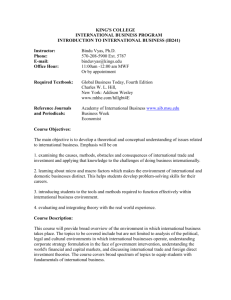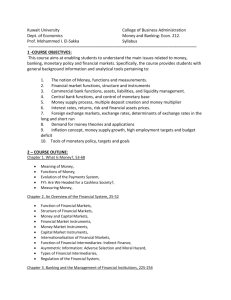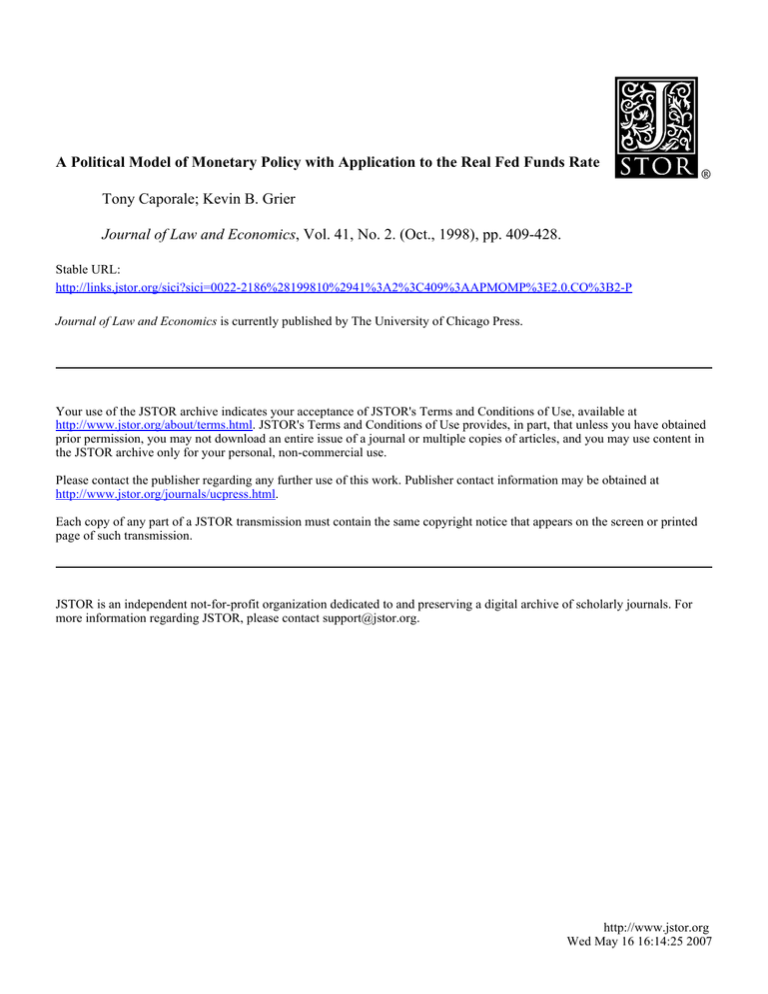
A Political Model of Monetary Policy with Application to the Real Fed Funds Rate
Tony Caporale; Kevin B. Grier
Journal of Law and Economics, Vol. 41, No. 2. (Oct., 1998), pp. 409-428.
Stable URL:
http://links.jstor.org/sici?sici=0022-2186%28199810%2941%3A2%3C409%3AAPMOMP%3E2.0.CO%3B2-P
Journal of Law and Economics is currently published by The University of Chicago Press.
Your use of the JSTOR archive indicates your acceptance of JSTOR's Terms and Conditions of Use, available at
http://www.jstor.org/about/terms.html. JSTOR's Terms and Conditions of Use provides, in part, that unless you have obtained
prior permission, you may not download an entire issue of a journal or multiple copies of articles, and you may use content in
the JSTOR archive only for your personal, non-commercial use.
Please contact the publisher regarding any further use of this work. Publisher contact information may be obtained at
http://www.jstor.org/journals/ucpress.html.
Each copy of any part of a JSTOR transmission must contain the same copyright notice that appears on the screen or printed
page of such transmission.
JSTOR is an independent not-for-profit organization dedicated to and preserving a digital archive of scholarly journals. For
more information regarding JSTOR, please contact support@jstor.org.
http://www.jstor.org
Wed May 16 16:14:25 2007
A POLITICAL MODEL OF MONETARY POLICY WITH APPLICATION TO THE REAL FED FUNDS RATE* TONY CAPORALE
Ohlo Unlversfh
and
KEVIfi B CRIER
Centro de
I~lvestlgacldn
j Docencca
Econdn~ltus
We construct an empirical model of U.S. monetary policy assuming that the Federal Reserve is an ordinary federal bureaucracy. We use the real Federal Funds rate
as our policy measure and show the existence of significant executive. legislative,
and bureaucratic influence on the real rate of interest from 1961 to 1996. We find
that presidential party is an adequate statistical measure of executive influence and
that the voting scores of the Senate Banking Committee leadership best represent
legislative influence. We argue that political changes cause systematic and predictable changes in monetary policy.
T H E Federal Reserve must have a fantastic press agent. While critical inquiries into government bureaus abound, and citizen cynicism and distrust
of elected officials and institutions run high, the Fed enjoys almost a free
pass. We all know that the Fed is different, independent, apolitical. Indeed,
usual scientific models of bureaucracy based on self-interest are generally
assumed not to apply to the monetary bureaucracy.
If the Fed did not enjoy this special status, how would we model its behavior? Presumably we would be guided by the positive models of bureaucratic behavior that exist in both the economics and political science literature. We would examine the effect of presidential influence on Fed
decisions. We would look for evidence of congressional influence and investigate whether changes in internal Fed leadership affect policy outcomes. Here we take up exactly this task. We ask the question, How much
explanatory leverage on monetary policy can we achieve by modeling the
* We wish to thank without implicating Robin Grier, Mike Munger. Doug Nelson, and
Bob Tollison for their helpful comments. Coeditor Sam Peltzman and an anonymous referee
also provided useful suggestions. Any remaining errors are ours alone.
[Journal o f h w and Economics, vol. XLI (October 1998)] O 1998 by The University of Chicago. All rights reserved. 0022-21 8619814102-0004$01.50 410
THE JOURNAL OF LAW AND ECONOMICS
Fed exactly as we would model the Federal Trade Commission or the International Trade Commission or the Securities Exchange Commission or the
Environmental Protection Agency?
It turns out that we can explain a lot about monetary policy by applying
usual models of bureaucratic behavior. Using the real Fed Funds rate to
measure monetary policy, we find that Republican presidents and more conservative leadership of the Senate Banking Committee are significantly correlated with tighter monetary policy. We also find that changes the chairmanship of the Fed are significantly correlated with changes in monetary
policy.
Section I below is a review of the empirical literature of political models
of Fed behavior. Section I1 explains our choice of monetary policy indicator. Section I11 presents the specific hypotheses we will test. Section IV
contains our main empirical results and some specification tests, and Section V contains our conclusions.
Empirical models of political influence on the Fed do exist, but they are
frequently monocausal models, and to date, they have not had much effect
on empirical macroeconomics. There are three general classes of models
considered here: bureaucratic independence, presidential partisan, and congressional partisan.'
Perhaps the most widely held view in both economics and political science is that the Fed is an independent bureau. There are at least three versions of this model. First, the traditional macroeconomic version is that the
Fed has some well-defined loss function made up entirely of macroeconomic
variables that is minimized subject to the constraints inherent in the economy. This loss function is viewed as impervious to politics. Virtually all
macroeconomic analyses of monetary policy proceed with this assumption.
Second, the public choice version is based on the Niskanen model of bureaucratic independence and argues that the Fed is free to pursue power,
wealth, or the interests of commercial banks independent of any political
control.' Mark Toma, Milton Friedman, and William Shughart and Robert
' There is also a considerable literature investigating the voting behavior of members of
the Board of Governors or the entire Federal Open Market Committee. See, for example,
Henry Chappell, Jr., Thomas Havrilesky, & Rob Roy McGregor, Partisan Monetary Policies:
Presidential Influence through the Power of Appointment, 108 Q. J. Econ. 185 (1993); and
George Krause, Federal Reserve Policy Decision Making: Political and Bureaucratic Influences, 38 Am. J. Pol. Sci. 124 (1994). However, this literature has yet to make the leap from
factors affecting the probability of dissenting votes to how those votes actually influence
monetary policies.
William Niskanen, Bureaucracy and Representative Government (1971).
'
POLITICAL MODEL OF MONETARY POLICY
41 1
Tollison all provide examples of this approach, which frequently concludes
that bureaucratic autonomy imparts an inflationary bias to monetary policy.'
The power of the Fed chairman is an important factor in a third class of
independent bureau models. Besides nontechnical analyses of the "Volcker
recession7' and the "Greenspan bull market," there is an economic literature that views the identity and preferences of the chairman as the major
factor determining subsequent monetary policy. David Hakes makes this
type of argument and presents supporting empirical work showing that a
monetary policy reaction function has significantly different coefficients during the Burns years as Fed chair than during either the Martin or Volcker
years.'
Presidential partisan models are built on the assumption that liberal politicians are more concerned with unemployment (or growth) and less with
inflation than are their conservative opponents and will thus pursue more
expansionary policies. When applied to the United States, Democratic presidents are considered liberal relative to Republicans. Douglas Hibbs develops a such a model assuming an exploitable Phillips curve. He presents regression evidence that monetary policy is significantly easier under
Democratic presidents. Later, Henry Chappell and William Keech and Alberto Alesina modify the partisan model to allow for rational expectations.'
However, their predictions about monetary policy are unchanged from
Hibbs's original model: Democratic presidents will be associated with more
expansionary policies.
Nathaniel Beck challenges Hibbs by arguing that not all Democrats are
alike and that a model using dummy variables for individual presidential
administrations fits the data significantly better than does a model using
only a party dummy. Dudley Luckett and Glenn T. Potts, Robert E. Weintraub, and Hakes also argue that presidential influence on the Fed is administration specific6 This is important because a party-based model has preMark Toma, Inflationary Bias of the Federal Reserve System: A Bureaucratic Perspective, 10 J. Monetary Econ. 163 (1982); Milton Friedman, Monetary Policy: Theory and Practice, 14 J. Money, Credit, & Banking 98 (1982); William F. Shughart I1 & Robert Tollison,
Preliminary Evidence on the Use of Inputs by the Federal Reserve System, 73 Am. Econ.
Rev. 291 (1983).
' David Hakes, The Objectives and Priorities of Monetary Policy under Different Federal
Reserve Chairmen, 22 J. Money, Credit, & Banking 327 (1990).
Douglas Hibbs, Political Parties and Macroeconomic Policy, 71 Am. Pol. Sci. Rev. 1467
(1977); Henry Chappell, Jr., & William Keech, Policy Motivation and Party Differences in
a Dynamic Spatial Model of Party Competition, 80 Am. Pol. Sci. Rev. 881 (1986); Alberto
Alesina, Macroeconomic Policy in a Two-Party System as a Repeated Game, 102 Q. J. Econ.
651 (1987).
Nathaniel Beck, Presidential Influence on the Federal Reserve, 26 Am. J. Pol. Sci. 415
(1982); Dudley G. Luckett & Glenn T. Potts, Monetary Policy and Partisan Politics, 12 J.
'
412
THE JOURNAL OF LAW A N D ECONOMICS
dictive content while administration dummies cannot be used to predict the
behavior of future presidents.
Congressional partisan models are simply the legislative branch counterparts to presidential partisan models.' Most of the literature on Congress
and the Fed is a litany of the infrequent, unsophisticated oversight and a
recounting of proposed legislation attacking the Fed that is never passed.
However, Kevin Grier, drawing on Barry Weingast and Mark Moran, Matthew McCubbins and Thomas Schwartz, and Weingast and William Marshall, argues that a lack of overt, organized congressional attention to monetary policy is not the same as a lack of i n f l u e n ~ e . ~
Grier argues that liberal legislators will prefer more expansionary policies and offers as supporting evidence that union political action committees (PACs) give more money to more liberal congressmen while corporate
PACs give more to conservative congressmen. He shows that changes in
the liberality of the Senate Banking Committee leadership, as measured by
average Americans for Democratic Action (ADA) scores, are positively
correlated with money growth in a variety of models and samples up to
the mid 1980s.' Thomas Havrilesky constructs an index of Senate Banking
Committee signals about more expansionary policy and shows that this index is negatively correlated with the Fed Funds rate.''
Not all empirical work on the politics of monetary policy takes a monocausal point of view. Hakes looks at the effect of both presidents and Fed
chairs on an index of monetary policy intentions, and Grier includes a variable for Republican presidents in his studies of congressional influence on
money growth. Havrilesky includes both executive and Banking Committee
Money, Credit, & Banking 540 (1980); Robert E. Weintraub, Congressional Supervision of
Monetary Policy, 4 J. Monetary Econ. 341 (1978); Hakes. supra note 4.
Interestingly, the existing presidential partisan models typically ignore even the possibility of congressional influence on the Fed. John Woolley, The Politics of Monetary Policy: A
Critical Review, 14 J. Pub. Pol'y 57, 73 (1994) remarks, "In typical models . . . changes in
Congress have little or no impact on the partisan character of monetary policy in addition to
the impacts caused by the president. . . . The general failure of most scholars to incorporate
terms representing both congressional and presidential political characteristics in their studies
is a telling failure."
Kevin Grier, Congressional Influence on U.S. Monetary Policy, 28 J. Monetary Econ.
201 (1991); Kevin Grier, Congressional Oversight Committee Influence on U.S Monetary
Policy Revisited, 38 J. Monetary Econ. 571 (1996); Barry Weingast & Mark Moran, Bureaucratic Discretion or Congressional Oversight? Regulatory Policy-Making by the Federal
Trade Commission, 91 J. Pol. Econ. 765 (1983); Matthew McCubbins & Thomas Schwarts,
Fire Alarms and Police Patrols, 28 Am. J. Pol. Sci. 165 (1984). Bany Weingast & William
Marshall, The Industrial Organization of Congress, 96 J. Pol. Econ. 132 (1988).
Grier, Congressional Influence on U.S. Monetary Policy, supra note 8; and Congressional Oversight Committee Influence on U.S Monetary Policy Revisited, supra note 8.
l o Thomas Havrilesky, The Pressures on American Monetary Policy (1993).
'
POLITICAL MODEL OF MONETARY POLICY
413
signals in a single regression." Tony Caporale and Grier argue that changes
in presidential administrations explain real Treasury-bill rate shifts better
than do Fed chair switches." Their final model contains dummies for presidential administration along with a dummy for Republican party control of
the Senate. However, there is no existing empirical work that allows for
simultaneous executive, congressional, and bureaucratic influence on monetary policy. We take up this task in Section IV below after explaining our
choice of policy variable and elucidating the specific hypotheses of interest.
Choosing an empirical measure of monetary policy is not an easy task.
There is a trade-off between picking a variable over which the Fed has direct and complete control (for example, the discount rate) and one that has
important implications for the macro economy but is only very imperfectly
controlled by the Fed in the short run (for example, the inflation rate). Historically, the debate has centered on the choice of a monetary aggregate
versus an interest rate. However, given the breakdown of the relationship
between narrow monetary aggregates and economic activity that began in
the mid 1980s, the use of interest rates or interest-rate spreads to measure
monetary policy is gaining widespread acceptance in empirical macroeconomics.
A number of recent papers show that interest rates and interest-rate
spreads are robust predictors of economic activity." Ben Bernanke argues
that these variables work well because they contain information about the
stance of monetary policy.'' In fact, Bernanke and Alan Blinder show that
I ' Hakes, supra note 4: Grier, Congressional Influence on U.S. Monetary Policy, supra
note 8; and Congressional Oversight Committee Influence on U.S Monetary Policy Revisited,
supra note 8; Havrilesky, supra note 10.
'' Tony Caporale & Kevin Grier, Political Regime Change and the Real Interest Rate
(photocopy, Tulane University, Murphy Institute of Political Economy, 1997).
'' James Stock & Mark Watson, Interpreting the Evidence on Money-Income Causality,
40 J. Econometrics 161 (1989); Benjamin Friedman & Kenneth Kuttner, Money, Income,
Prices, and Interest Rates, 82 Am. Econ. Rev. 472 (1992); Ben Bernanke & Alan Blinder,
The Federal Funds Rate and the Channels of Monetary Transmission, 82 Am. Econ. Rev.
901 (1992).
" Ben Bernanke, On the Predictive Power of Interest Rates and Interest Rate Spreads,
1990 New Eng. Econ. Rev. 51. A similar conclusion was reached by Robert Laurent, An
Interest Rate-Based Indicator of Monetary Policy, 12 Econ. Persp. 3 (1988). More recently,
Ben Bernanke & Ilian Mihov, Measuring Monetary Policy (Working Paper No. 5145, National Bureau of Economic Research, Cambridge, Mass. 1995), attempted to obtain a measure
of monetary policy innovations by employing a "semistructural" vector autoregression
model. Using a monthly sample from 1966 to 1994, they were unable to reject the identifying
restriction of Federal Funds rate targeting. They argue that this provides further evidence that
414
THE JOURNAL OF LAW AND ECONOMICS
over much of the past 30 years the Fed has implemented policy changes
primarily through changes in the Federal Funds rate.'' They conclude that
the Funds rate may therefore be used as an indicator of policy stance. In
this article we use the real Federal Funds rate, defined simply as the nominal rate less the actual inflation rate, as our measure of monetary policy.
Using real rates is consistent with the empirical macroeconomic literature
cited above since lags of the price level are included in those empirical
studies.16
Real interest rates are what affect the macro economy, and nominal rates
may often be poor indicators of real rate movements." Yet one possible
objection to using real rates to measure monetary policy is the argument
that real interest rates are not affected by systematic economic policies. In
fact, Eugene Fama argued that the real interest rate was constant, at least
over the 1953-71 sample period he studied." Fama's work inspired a
stream of papers showing that the real rate does vary, and many of those
papers show that policy affects real rates. Fed Chairman Alan Greenspan,
in 1993 congressional testimony, acknowledged the Fed's influence over
the real rates: "Currently, short-term real rates, most directly affected by
the Federal Reserve, are not far from zero; long-term rates, set primarily
by the market, are appreciably higher."I9
Statistical models of the real rate have evolved from Fama's famous
piece, claiming the real rate was basically constant, to William Schwert and
the Fed Funds rate is the best indicator of monetary policy. Finally, studies by James Pierce,
The Myth of Congressional Supervision of Monetary Policy, 4 J. Mon. Econ. 363 (1978);
and Robert Hetzel, The Federal Reserve System and the Control of the Money Supply in the
1970s, 13 J. Money, Credit, & Banking 31 (1981), have shown that the open-market desk of
the New York Fed is able to k e e ~the Funds rate within the band set by the Federal O ~ e n
Market Committee.
'' Benanke & Blinder, supra note 13.
I b This point is clearly made by id. at 905: "Lags of the price level are included for comparability with previous literature and because it is presumably real money or real interest
rates that effect real variables."
" For example, in 1979, 3-month Treasury bills averaged a return of about 10 percent, yet
with a corresponding inflation rate of almost 12.5 percent, people holding those bills actually
became poorer. In contrast, the average nominal return on 3-month bills in 1986 was about
6 percent. However, given the inflation rate of 1.2 percent, the average real return to holding
Treasury bills was 4.8 percent. Simply looking at nominal rates would lead one to the odd
conclusion that policy was much more restrictive in 1979 than it was in 1986. Throughout
the decade of the 1970s there is actually a negative and significant correlation between nominal and real interest rates.
l 8 Eugene Fama, Short-Term Interest Rates as Predictors of Inflation, 65 Am. Econ. Rev.
269 (1975).
l 9 Alan Greenspan, Statement before the Subcommittee on Economic Growth and Credit
Formation of the Committee on Banking, Finance, and Urban Affairs, U.S. House of Representatives, July 20, 1993, 79 Fed. Res. Bull. 849, 853 (1993) (emphasis added).
POLITICAL MODEL OF MONETARY POLICY
415
Madelyn Antoncic, who argue that the real interest rate is actually nonstationary, to Pierre Perron and Rene Garcia, who show that the real rate is
constant over substantial periods of time but subject to infrequent shifts in
its mean. Caporale and Grier show that big political changes predict real
rate shifts better than the time-series method used by Garcia and Perron
over the Garcia-Perron sample period of 1961-86.'O
In the empirical work presented below, we expand the sample to also
include the decade 1987-96, we switch from considering the real Treasurybill rate to the real Federal Funds rate, and most important, we seek to improve on Caporale and Grier by creating an empirical model with ex ante
predictive power. The following section sets out the specific hypotheses we
will examine.
Our empirical work investigates the effects of bureaucratic structure, executive influence, both partisan and electoral, and the influence of Congress
in an integrated political model of monetary policy. There are three hypotheses of particular interest.
HYPOTHESIS1. DO changes in the executive branch affect the real
Funds rate, and if so, does party adequately capture these effects?
HYPOTHESIS
2. DO changes in the composition of Congress affect real
rates, and if so, is it in the overall Congress, the banking committees, or the
committee's leadership?
HYPOTHESIS
3. DO changes in the Fed chairmanship affect the real
Funds rate, and if so, are chairs with previous Fed experience systematically different from chairs appointed from the outside, or are chairs appointed by Democrat presidents different from those appointed by Republicans?
The next section begins sorting out these hypotheses in a politics-only
regression model and then proceeds to investigate the robustness of our results with a set of specification tests and by adding sets of macroeconomic
variables. It is important to emphasize, however, that all our conclusions
about political influence drawn from the politics-only model continue to
hold in our later, macro-variables-included models. We use the two stages
here only for convenience of exposition, not to influence the results.
'"Id.; G. William Schwert, The Time Series Behavior of Real Interest Rates: A Comment,
24 Carnegie-Rochester Conference Series on Public Policy 275 (1986); Madelyn Antoncic,
High and Volatile Real Interest Rates: Where Does the Fed Fit In? 18 J. Money, Credit, &
Banking 18 (1986); Pierre Perron, Testing for a Unit Root in a Time Series with a Changing
Mean, 8 J. Bus. & Econ. Stat. 153 (1990); Rene Garcia & Pierre Perron, An Analysis of the
Real Interest Rate under Regime Shifts, 78 Rev. Econ. & Stat. 11 1 (1996): Caporale & Grier,
supra note 12.
416
THE JOURNAL OF LAW AND ECONOMICS
TABLE 1
Variable
Equation (1)
Equation (2)
Equation (3)
Constant
3.95
(1.45)
-1.30
(4.60)
.57
(.69)
6.59
(2.29)
-1.19
(2.74)
-. 17
(.21)
1.19
(2.18)
.3 1
(.29)
2.47
(1.78)
.07
1.54
(.59)
-1.58
(6.25)
1.06
(1.57)
log(Senate committee leadership)
log(House committee leadership)
Nixon-Ford dummy
...
Carter dummy
.
Reagan-Bush dummy
...
Clinton dummy
...
Republican president dummy
..
...
...
...
1.84
(5.15)
-2.57
(4.90)
-2.16
(4.12)
.75
(1.33)
Bums dummy
Miller dummy
Volcker dummy
Greenspan dummy
Fed insider dummy
NOTE.-In each equation. three seasonal dummies are estimated but not reported to conserve space.
Sample is 1961.1- 1996.4, 144 quarterly observations. Numbers in parentheses are heteroskedasticity and
autocorrelation consistent r-statistics computed with a lag truncation parameter of 4. Fed insider chairs
are Martin and Volcker.
IV.
RESULTS
Equation ( I ) of Table 1 presents a simple political model of the real Federal Funds rate. We use a dummy variable for Republican presidents and
for each Fed chair except for Martin. The intercept thus measures the combined coefficients for Martin and Democratic presidents. To represent Congress we use an updated measure of Banking Committee preferences for
monetary policy developed by Grier." We take the average ADA score of
each member for the length of time they serve on the committee and use
"
Grier, Congressional Influence on U.S. Monetary Policy, supra note 8; and Congressional Oversight Committee Influence on U.S Monetary Policy Revisited, supra note 8.
POLITICAL MODEL OF MONETARY POLICY
417
that as fixed measure of their preferences. We then take an average of this
average preference across the committee chair and the relevant subcommittee chairs (see appendices A and B for a listing of the members and their
average ADA scores). Voting scores, if significant, provide more ex ante
predictions than do party dummy variables.
Equation 1 of Table 1 shows that a more liberal Senate Banking Committee leadership is significantly negatively correlated (at the 0.01 level) with
the real interest rate, while the House leadership has no significant effect.
The coefficient for the Senate indicates that a 1-SD increase in the average
ADA of the Senate committee leadership reduces the real Fed Funds rate
by 0.98 percentage points, other factors held constant.
The Republican president dummy variable has a coefficient of 1.84 and
is significant at the 0.01 level. Ceteris paribus, the real Fed Funds rate is
almost 2 percentage points higher under Republicans. The Fed chair dummies are jointly significant at the 0.05 level, with the Burns and Miller dummies each negative and significant.
We find strong statistical evidence of systematic, predictable influence of
politics on monetary policy. Perhaps the most surprising result here is that
this simple political model accounts for about 60 percent of the quarterly
variation in the real rate over the 36 years from 1961 to 1996.
A.
Does P a r e Adequately Captzire Executive Injuence?
Equation (2) relaxes the constraint that all Republican administrations are
alike and that all Democratic administrations are alike by replacing the Republican president dummy with separate administration-specific dummy
variables. The Kennedy-Johnson administration is measured by the intercept (along with Fed Chair Martin) and Nixon-Ford, Carter, Reagan-Bush,
and Clinton dummies are in the regression. The administration dummies do
not add much to the party model in equation (1). The R2 of equation (2) is
only 0.005 higher, and a formal F-test cannot begin to reject the null hypothesis that the simple party dummy variable fits the data as well as the
individual administration dummies.
In equation (2), the Senate Banking Committee leadership is still negative and significant at the 0.01 level, and the House committee leadership
is still insignificant. The Fed chair dummies are still significant at the 0.05
level, and their coefficients and significance levels are little changed.
The ability to use a party variable supports earlier work of Hibbs and, as
he stressed, converts the model from mere ex post explanation to one that
can make ex ante predictions. The success of the party variable here also
supports the partisan models common in the literature that take presidential
party as the organizing political force.
41 8
THE JOURNAL OF LAW AND ECONOMICS
B.
Searching for Predictive Content in the Fed Chair Dummies
So far the model has ex ante predictions for the effect of legislative and
executive branch changes on monetary policy. Here we examine whether
there exists ex ante predictability for Fed chair changes. Equation (3) tests
the hypothesis that Fed chairs can be grouped by whether or not they had
previous Fed experience. We replace the four Fed chair dummies with a
Fed Insider dummy that equals 1.0 for the Martin and Volcker years and
0.0 for the rest of the sample. The Fed Insider variable is positive and significant at the 0.01 level, indicating that the real rate is significantly higher
under a Fed chair with previous fed experience. However, the fit of the
model is significantly worse in equation (3) than in equation (2). An F-test
for the appropriateness of grouping Fed chairs by insider-outsider status rejects that hypothesis at the 0.01 level.
A second possibility is that Fed chairs could be grouped according to the
party of the president that appointed them. Martin, Miller, and Volcker
were appointed by Democratic presidents, while Burns and Greenspan were
Republican president appointees. The weakness of this hypothesis can be
clearly seen by examining the individual coefficients in equation (2) of Table 1. Both Bums and Miller have negative and significant coefficients, but
one is a Republican-appointed chair, and the other a Democrat appointee.
Replacing the individual Fed chair dummies with a Democrat appointee
dummy lowers the R2 of the model to 0.43. An F-test convincingly rejects
the null hypothesis that the party of the appointing president can predict
what effect a Fed chair will have on the real interest rate.
This last result indicates that the theoretical literature emphasizing the
power of appointment may be in error. Fed policy is affected by the election
of a Democratic president, even if the chair was previously appointed by a
Republican. It also can help to explain why Volcker and Greenspan were
reappointed by presidents of the opposite party that originally appointed
them.
C. Is Banking Committee Leadership the Right Measure oj Congressional Preference? In Table 2 we take a closer look at the effect of congressional change on
the real rate. We have constructed our committee leadership variable so that
only changes in personnel will change our measure of committee preference. As Dan Wood and Richard Waterman point out, committee personnel
change is often correlated with larger congressional change." Therefore, it
?' Dan Wood & Richard W. Waterman, Bureaucratic Dynamics 143 (1994), say, "When
Congress changes, so do the parts of Congress. Thus it is impossible to determine whether
bureaucratic responses are due to the entire body, one or more oversight committees or a
POLITICAL MODEL OF MONETARY POLICY 419
TABLE 2 Variable
Equation (1)
Equation (2)
Equation (3)
Constant
log(Senate committee leadership)
log(House committee leadership)
log(ful1 Senate committee average)
log(ful1 House committee average)
Percent Democrats in Senate
Percent Democrats in House
Republican president dummy
Bums dummy
Miller dummy
Volcker dummy
Greenspan dummy
R
'
- -
NOTE.-^ each equation, three seasonal dummies are estimated but not reported to conserve space.
Sample is 1961.1-1996.4, 144 quarterly observations. Numbers in parentheses are heteroskedasticity and
autocorrelation consistent t-statistics computed with a lag truncation parameter of 4.
is not enough to show that our variable is significant; we need to investigate
whether other congressional variables are also significant and, if so, which
fit the data best.
Equation (1) of Table 2 replaces the committee leadership ADA scores
with the average ADA score of the entire committee. Both of these variables have negative coefficients, but they are individually and jointly insignificant. Equation (2) considers the composition of the entire Congress.
Since the average ADA score for a full chamber shows little time variation,
we use instead the percentage of the chamber that belongs to the Democratic party. The percent Democrat in the Senate is negative and significant
multiplicity of forces in the environment of the agency." We would of course replace the
word "impossible" with the word "important" and argue that, for the Fed at least, we are
doing exactly that.
420
THE JOURNAL OF LAW AND ECONOMICS
at the 0.01 level, while the percent Democrat in the House is completely
insignificant.
To investigate which measure is the appropriate one, we simply put both
in the same equation. These results are shown in equation (3) of Table 2.
The Senate Banking Committee leadership dominates the percent Democrat
in the Senate as an influence on the real rate. The committee leadership
variable is negative and significant at the 0.01 level, while the broader measure is completely insignificant.
Another way to gauge the appropriateness of our selection of the Senate
Banking Committee as the major congressional influence variable is to consider the stability of its coefficient over time. It is difficult to conduct a
straightforward Chow test for the stability of the overall equation because
the model contains a number of dummy variables that cannot be estimated
(because they equal zero throughout) over many subsamples. However, we
can investigate the stability of our Congress variable by creating another
dummy variable that equals 1.0 in the second half of our sample (from
1979.1-1996.4) and 0.0 in the first half, then interacting it with the Senate
Banking Committee variable. If the significance of the committee variable
is being driven by the changes in the party controlling the Senate in 1980,
1986, and 1994, then the interaction term might be negative and significant,
and the original coefficient insignificant.
However, this is not the case. In the regression described above, the coefficient on the Senate Banlung Committee leadership is - 1.20 with a t-statistic of 3.23, and the slope-shifting interaction term has a coefficient of -0.10
with a t-statistic of 0.45. We thus find no evidence that the effect of Senate
Banlung Committee leadership preferences on the real rate changes after
1978."
D.
SpeciJication Tests
The political variables we use in our analysis are generally significant
and together explain a substantial fraction of the variation in the real interest rate. Of course, it may well be the case that we have left relevant variables out. For example, we ignore the overall composition of the Board of
Governors, and we do not explicitly consider the alleged 1979 experiment
*' We also estimated a nominal Fed Funds rate equation with the inflation rate included
on the right-hand side. Rather than using least squares, though, we recognize that inflation
and the nominal rate are simultaneously determined and thus use two-stage least squares with
the inflation rate as an endogenous regressor. The basic results shown in Tables 1 and 2
are unaffected by this change. The political variables have the same signs, magnitudes, and
significance levels as they did in our real rate equations, and the now freely estimated coefficient on inflation is almost exactly equal to 1.0. Given that our previous equation imposes
such a value on the coefficient, it is important to show that the data do not reject it.
POLITICAL MODEL OF MONETARY POLICY
42 1
with monetarism undertaken by the Fed. One good way to check the validity of a model against some unspecified alternatives is to use a general specification test. If the equation fails, one can conclude that important factors
are missing from the model. Here we perform the Ramsey RESET test" on
equation (1) of Table 1. The RESET test adds powers of the predicted values from the regression model in question into a new augmented model.
For example, if the original model is y = xB + p and y' is the vector of
fitted values from that regression, the Ramsey test estimates the model y =
xB xy'y" + p. If the y,s are jointly significant, we conclude that the existing model is inadequate. We have conducted Ramsey tests with i equal
to 2, 3, and 4. In each case the test statistic is insignificant, indicating that
we have not made an egregious error of omission.
+
E. Macro Variables
Finally, we show that our results about systematic political influence on
monetary policy are robust to the inclusion of macroeconomic variables as
additional regressors. Economic theory suggests that both the supply and
demand of investment funds should influence the real interest rate. To control for factors affecting the demand for investment funds, we use real stock
returns, relative energy prices, and lagged investment. To control for the
supply of loanable funds, we use the federal deficit, government spending,
and growth in the monetary base. Appendices C and D give the exact definitions, sources, and summary statistics for all our variables.
Consider the demand for investment funds. In an efficient-market model,
stock prices are based on the present value of expected future profits. Increases in the rate of return to the stock market are thus signals of increases
in expected future economic growth and profits. Higher expected growth
raises investment demand and the interest rate, assuming that other relevant
Increases in the real price of energy are negative
factors are held con~tant.'~
supply shocks that imply lower levels of future economic activity and therefore will reduce investment demand and lower the real rate of interest.
Turning to the supply side, traditional Keynesian macro models predict
?' James Ramsey, Tests for Specification Errors in Classical Linear Least Squares Regression Analysis, 31 J. Royal Stat. Soc'y 350 (1969).
25 Our macro variables are largely based on the model found in Robert Barro & Xavier
Sala-i-Martin, World Real Interest Rates, NBER Macroeconomics Annual 15 (Olivier Blanchard and Stanley Fischer eds. 1990). Like them, we use real stock returns rather than real
GNP as the relevant variable affecting the demand for investment. Frederic Mishkin, The
Real Interest Rate: An Empirical Investigation, 15 Carnegie-Rochester Conf. Series on Pub.
Pol'y 151 (1981); and Behzad Diba & Seonghwan Oh, Money, Output, and the Expected
Real Interest Rate, 47 Rev. Econ. & Stat. 10 (1991), both find that GNP does not significantly
affect the real interest rate.
THE JOURNAL OF LAW AND ECONOMICS
TABLE 3
Variable
Coefficient
t-Statistic
Constant log(Senate committee leadership) log(House committee leadership) Republican president dummy Bums dummy Miller dummy Volcker dummy Greenspan dummy Real oil price growth,-, Monetary base growth,-, Real stock returns,-, Government spending/GNP,-, Investment/GNP,-, Deficit/GNP,, R'
NOTE.-Three seasonal dummies are estimated but not reported to
conserve space. Sample is 1961.1-1996.4, 144 quarterly observations.
Numbers in parentheses are heteroskedasticity and autocorrelation consistent t-statistics computed with a lag truncation parameter of 4. GNP
= gross national product.
that government borrowing to finance a deficit will reduce the amount of
savings available for private investment. The reduction in the supply of
loanable funds will tend to raise the real interest rate. A major controversy
in macroeconomics is whether deficits do raise real interest rates, and the
empirical evidence is mixed.26We include the deficit variable here without
making any strong a priori prediction about its sign or significance. Finally,
if the price level does not adjust instantly to increases in money, then a
monetary expansion at least temporarily increases the real supply of funds
(liquidity) in the economy, tending to lower the real rate of interest until
the price level fully adjusts. We use monetary base (MO) growth as our liquidity variable. We measure the financial variables as continuously compounded growth rates and the spending variables as a percentage of gross
national product (GNP). To lessen any potential simultaneity problems, we
lag each variable one quarter.
Table 3 adds the six macro variables discussed above, each lagged one
''
Robert Barro, Are Government Bonds Net Wealth? 82 J. Pol. Econ. 1095 (1974), makes
the Ricardian equivalence argument that, for a given level of government spending, the
choice between tax or deficit financing has no effect on real variables. Douglas Bernheim,
Ricardian Equivalence: An Evaluation of Theory and Evidence, NBER Macroeconomics Annual 263 (Stanley Fischer ed. 1987), presents a good survey of the empirical evidence on
crowding out.
POLITICAL MODEL OF MONETARY POLICY
423
quarter, to our basic political model. The six variables are jointly significant
at the 0.01 level and raise the R2 of the model from 0.597 to 0.653. Relative
energy price growth is negative and significant at the 0.01 level, and the
deficit is positive and significant at the 0.05 level. Investment is positive
and significant at the 0.10 level, while the other three variables have the
expected signs but are not individually significant. The equation reported in
Table 3 produces the same set of conclusions regarding our three political
hypotheses as does the politics-only models we have reported, and it passes
the same set of specification tests applied to the politics-only model in the
subsection above."
The empirical work above demonstrates that the Federal Reserve is not
so different from the International Trade Commission or the Federal Trade
Commission or any other federal bureau in that at least one of its outputs,
monetary policy, is significantly affected by political changes. While it is
true that presidents have a lot of other things to do, that formal congressional oversight is sporadic and unsophisticated, and that the Fed scores
reasonably high in cross-national indexes of legal independence, our results
are too strong to be swept aside by quibbles over the lack of overt control.
Politics matters and knowledge about political changes can help forecast
monetary policy.
In the 1961-96 sample studied here, presidential influence can be adequately captured with a party variable, supporting the partisan models of
Hibbs, Chappell and Keech, and Alesina. Congressional influence comes
through the leadership of the Senate Banlung Committee, supporting previous work by Grier and Havrilesky. Finally, although we show that changes
in the identity of the Fed chair significantly change monetary policy, the
direction of these changes are not ex ante predictable. We find that monetary policy under Fed chair insiders is tighter than under outsiders, but the
data do not fully accept the restriction; individual chairman dummies fit the
data better.
Our work illustrates the utility of political economy models in empirical
macroeconomics. Models of Fed behavior can no longer be based on out-
" We also investigate using eight lags of inflation along with our political variables. The
inflation variables are significant at the 0.01 level, but more important for our purposes, they
do not change the signs, magnitudes, or significance levels of the coefficient on our political
regressors. Senate Banking Committee leadership continues to have a significant negative
association with the real rate, Republican presidents still have a significant positive association, and the Fed chair dummies are still significant at the 0.01 level with the Bums and
Miller coefficients significantly negative.
424
THE JOURNAL OF LAW AND ECONOMICS
ward appearances or "common knowledge" or the internal propaganda of
the organization. In the spirit of Will Rogers, it's not what you don't know
that hurts you, it's what you think you know that ain't so. Our results demonstrate that many of the things we "know" about the Fed and monetary
policy are in fact not true.
APPENDIX A TABLE A1 SENATE
B ANKING
COMMITTEE
LEADERSHIP,
1961-96
Date
Committee chair:
1961-66
1967-74
1975-80
1981-86
1987-88
1989-94
1995-96
Financial Institutions subcommittee chair: 1961-62 1963-66 1967-72 1973-78 1979-80 1981-82 1983-84 1985-86 1987-88 1989-94 1995-96 Production and Stabilization
subcommittee chair:
1961-66
1967-68
1969-70
1971-72
1973-74
1975-78
1979-80
1981-82
1983-84
1985-86
1987-92
1993-94
1995-96
NOTE.-ADA =
* After 1986 this
t After 1981 this
$ After 1993 this
tary Policy."
Leader
ADA Scores
Robertson (Va.)
Sparkman (Ala.)
Proxmire (Wis.)
Garn (Utah)
Proxmire (Wis.)
Riegle (Mich.)
D'Amato (N.Y.)
2.75
9.62
64.50
1.25
85
87.17
25
No such subcommittee formed
Robertson (Va.)
5.50
Proxmire (Wis.)
76.67
McIntyre (N.J.)
6 1.50
Cranston (Calif.)
83.50
Tower (Tex.)
10.00
Armstrong (Colo.)
7.50
Gorton (Wash.)
30.00
95.00
Reigle (Mich.)*
Dodd (Conn.)
71.83
Gramm (Tex.)
.00
Douglas (Ill.)
Long (Mo.)
Mondale (Minn.)
Cranston (Calif.)
Johnston (La.)
Cranston (Calif.)
Reigle (Mich.)
Armstrong (Cola.)?
Gorton (Wash.)
Mattingly (Ga.)
Sarbanes (Mass.)
Sasser (Term.)$
Bond (Mich.)
98.60
56.00
97.00
89.50
24.50
89.50
8 1.OO
7.50
35.00
.OO
93.00
75.00
7.50
Americans for Democratic Action. See text.
subcommittee was called "Securities."
subcommittee was called "Economic Policy."
subcommittee was called "International Finance and Mone-
POLITICAL MODEL OF MONETARY POLICY
APPENDIX B TABLE B1 HOUSEBANKING
COMMITTEE
LEADERSHIP,
1961-96
Date
Leader
Committee chair:
1961-62
1963-74
1975-80
1981-88
1989-94
1995-96
Domestic Finance:
1961-64
1965-76
1977-80
1981-86
1987-92
1993-94
1995-96
Bank Supervision and Insurance:
1961-64
1965-66
1967-68
1969-88
1989-92
1993-94
1995-96
ADA Scores
Spence (Ky .)
Patman (Tex.)
Reuss (Wis.)
St. Germain (R.I.)
Gonzalez (Tex.)
Leech (Iowa)
73.17
40.67
89.83
75.50
81.66
35.00
No such subcommittee
Patman (Tex.)
Mitchell (Md.)
Fountroy (D.C.)*
Neal (N.C.)
Kanjorski (Pa.)?
Roukema (N.J.)$
formed
32.17
92.25
68.67
66.00
62.50
42.50
No such subcommittee
Multer (N.Y.)
Moorehead (Pa.)
St. Germain (R.I.)
Annuzio (Ill.)
Neal (N.C.)
Castle (Del.)
formed
89.00
92.50
77.75
67.75
66.00
15.00
NOTE.-ADA = Americans for Democratic Action. See text.
* Since Fountroy is a D.C. delegate and does not vote, he is not assigned an
ADA score. We deal with this problem by assigning him the Democratic average.
iAfter 1993. this subcommittee was called "Economic Growth and Consumer
Credit."
$ After 1995. this subcommittee was called "Domestic and International Monetary Policy."
APPENDIX C
Real Rate: The ex post real Federal Funds rate. Data on the end-of-month Funds
rate were taken from the Citibase databank (FYFF). The rate was subtracted by the
annualized inflation rate.
Injution: The rate of inflation calculated as the annualized growth rate of the
consumer price index. Data on the nonseasonally adjusted consumer price index
were obtained from Citibase (PZUNEW).
Real Stock Returns: The annualized growth rate of the real Dow Jones price index. The nominal index was obtained from Citibase (FSDJ). It was deflated by the
consumer price index (PZUNEW).
MO Growth: The annualized growth rate in the monetary base was taken from
Citibase (FMBASE).
Investment Ratio: Gross investment as a percentage of GNP. The ratio of Citibase
variables GPI to GNP is multiplied by 100.
426
THE JOURNAL OF LAW A N D ECONOMICS
Spending Ratio: Government spending on goods and services as a percentage of
GNP. The ratio of the Citibase variables GGE to GNP is multiplied by 100.
Deficit Ratio: The ratio of the federal budget deficit to GNP. The ratio of the
Citibase variables GGFNET to GNP is multiplied by 100.
Energy: The annualized growth rate of the real price of crude petroleum. The
relative price of petroleum was obtained by dividing its producer price index
(PW57) by the overall producer price index (PW).
Committee Leadership: The average ADA scores for the Senate and House chairs
of the Banking Committee chair and two subcommittees that oversee the Fed over
the full period that the elected officials held a leadership position (from the Congressional Quarterly and the ADA).
Full Committee: The year-to-year average ADA scores of the entire Senate and
House Banking Committees.
Percent Democrat: The percentage of seats in the Senate and House held by legislators from the Democratic party (from the Congressional Quarterly).
APPENDIX D
TABLE D l
SUMMARY
STATISTICS,
196 1.1- 1996.4
Variable
Mean
SD
Real rate
Nominal Fed Funds rate
Inflation
Money base growth
Real stock price growth
Investment ratio
Spending ratio
Deficit ratio
Real oil price growth
Senate committee leadership ADA
House committee leadership ADA
Senate Banking Committee ADA
House Banking Committee ADA
Percent Democrats in the Senate
Percent Democrats in the House
2.16
6.81
4.65
6.67
2.26
.16
.21
- .02
.88
5 1.06
65.07
50.12
50.79
.57
.60
2.86
3.46
3.43
2.61
30.12
.02
.01
.02
28.06
27.39
15.13
5.35
6.09
.07
.05
Alesina, Alberto. "Macroeconomic Policy in a Two-Party System as a Repeated
Game." Quarterly Journal of Economics 102 (1987): 65 1-78.
Antoncic, Madelyn. "High and Volatile Real Interest Rates: Where Does the Fed
Fit In?" Journal of Money, Credit, and Banking 18 (1986): 18-27.
Barro, Robert. "Are Government Bonds Net Wealth?" Journal of Political Economy 82 (1974): 1095-1 17.
Barro, Robert, and Sala-i-Martin, Xavier. "World Real Interest Rates." In NBER
Macroeconomics Annual, edited by Olivier Blanchard and Stanley Fischer,
pp. 15-60. Cambridge, Mass.: MIT Press, 1990.
POLITICAL MODEL OF MONETARY POLICY
427
Beck, Nathaniel. "Presidential Influence on the Federal Reserve." American Journal of Political Science 26 (1982): 415-45.
Bernanke, Ben. "On the Predictive Power of Interest Rates and Interest Rate Spreads."
New England Economic Review, November-December 1990, pp. 5 1-68.
Bernanke, Ben, and Blinder, Alan. "The Federal Funds Rate and the Channels of
Monetary Transmission." American Economic Review 82 (1992): 90 1-2 1.
Bernanke, Ben, and Mihov, Ilian. "Measuring Monetary Policy." Working Paper No. 5145. Cambridge, Mass.: National Bureau of Economic Research, 1995. Bernheim, B. Douglas. "Ricardian Equivalence: An Evaluation of Theory and Evi- dence." In NBER Macroeconomics Annual, edited by Stanley Fischer, pp. 263303. Cambridge, Mass.: MIT Press, 1987.
Caporale, Tony, and Grier, Kevin. "Political Regime Change and the Real Interest
Rate." Photocopy. New Orleans: Tulane University, Murphy Institute of Political
Economy, 1997.
Chappell, Henry, Jr.; Havrilesky, Thomas; and McGregor, Rob Roy. "Partisan
Monetary Policies: Presidential Influence through the Power of Appointment."
Quarterly Journal of Economics 108 (1993): 185-21 8.
Chappell, Henry, Jr., and Keech, William. "Policy Motivation and Party Differences in a Dynamic Spatial Model of Party Competition." American Political
Science Review 80 (1986): 881-99.
Diba, Behzad, and Oh, Seonghwan. "Money, Output, and the Expected Real Interest Rate." Review of Economics and Statistics 73 (1991): 10-17.
Fama, Eugene. "Short-Term Interest Rates as Predictors of Inflation." American
Economic Review 65 (1975): 269-82.
Friedman, Benjamin, and Kuttner, Kenneth. "Money, Income, Prices, and Interest
Rates." American Economic Review 82 (1992): 472-92.
Friedman, Milton. "Monetary Policy: Theory and Practice." Journal of Money.
Credit, and Banking 14 (1982): 98-1 18.
Garcia, Rene, and Perron, Pierre. "An Analysis of the Real Interest Rate under Regime Shifts." Review of Economics and Statistics 78 (1996): 111-25.
Grier, Kevin. "Congressional Influence on U.S. Monetary Policy." Journal of
Monetary Economics 28 (1991): 201-20.
Grier, Kevin. "Congressional Oversight Committee Influence on U.S. Monetary
Policy Revisited." Journal of Monetary Economics 38 (1996): 571-79.
Hakes, David R. "The Objectives and Priorities of Monetary Policy under Different
Federal Reserve Chairmen." Journal of Money. Credit, and Banking 22 (1990):
327-37.
Havrilesky, Thomas. The Pressures on American Monetary Policy. Boston: Kluwer
Academic Publishers, 1993.
Hetzel, Robert. "The Federal Reserve System and the Control of the Money Supply
in the 1970s." Journal of Money, Credit, and Banking 13 (1981): 31-43.
Hibbs, Douglas, Jr. "Political Parties and Macroeconomic Policy." American Political Science Review 7 l (1977): 1467-87.
Krause, George. "Federal Reserve Policy Decision Making: Political and Bureaucratic Influences." American Journal of Political Science 38 (1994): 124-44.
Laurent, Robert. "An Interest Rate-Based Indicator of Monetary Policy." Economic
Perspectives, Federal Reserve Bank of Chicago 12 (January-February 1988): 3- 14.
428
THE JOURNAL OF LAW AND ECONOMICS
Lohmann, Susanne. "Optimal Commitment in Monetary Policy: Credibility versus
Flexibility." American Economic Review 82 (1992): 273-86.
Luckett, Dudley G., and Potts, Glenn T . "Monetary Policy and Partisan Politics."
Journal of Money, Credit, and Banking 12 (1980):540-46.
McCallum, Bennett. " A Reconsideration o f Sims' Evidence Concerning Monetarism." Economics Letters 13 (1983): 167-71.
McCallum, Bennett. "On 'Real' and 'Sticky-Price' Theories o f the Business Cycle." Journal of Money, Credit, and Banking 18 (1986):397-414.
McCubbins, Matthew, and Schwartz, Thomas. "Fire Alarms and Police Patrols."
American Journal of Political Science 28 (1984): 165-79.
Mishkin, Frederic. "The Real Interest Rate: An Empirical Investigation." Carnegie-Rochester Conference Series on Public Policy 15 (198 1 ) : 15 1-200.
Munger, Michael, and Roberts, Brian. "The Federal Reserve and Its Institutional
Environment: A Review." In The Political Economy of American M o n e t a ~Policy, edited by Thomas Meyer, pp. 83-98. Cambridge: Cambridge University
Press, 1990.
Perron, Pierre. "Testing for a Unit Root in a Time Series with a Changing Mean."
Journal of Business and Economic Statistics 8 (1990): 153-62.
Persson, Torsten, and Tabellini, Guido. Macroeconomic Policy, Credibility, and
Politics. New York: Harwood Academic Publishers, 1991.
Pierce, James. "The Myth o f Congressional Supervision o f Monetary Policy."
Journal of Monetary Economics 4 (1978):363-70.
Rogoff, Kenneth. "The Optimal Degree o f Commitment to an Intermediate Monetary Target." Quarterly Journal of Economics 100 (1985): 1169-89.
Schwert, G . William. "The Time Series Behavior o f Real Interest Rates: A Comment."
Carnegie-Rochester Conference Series on Public Policy 24 (1986):275-87.
Shughart, William F., 11, and Tollison, Robert. "Preliminary Evidence on the Use
o f Inputs by the Federal Reserve System." American Economic Review 73
(1983):291-304.
Sims, Christopher. "Comparison o f Interwar and Postwar Cycles: Monetarism Reconsidered," American Economic Review 70 (1980):250-57.
Stock, James, and Mark Watson. "Interpreting the Evidence on Money-Income
Causality." Journal of Econometrics 40 (1989): 161 -8 1 .
Toma, Mark. "Inflationary Bias o f the Federal Reserve System: A Bureaucratic
Perspective." Journal of Monetary Economics 10 (1982): 163-90.
Weingast, Bany, and Marshall, William. "The Industrial Organization o f Congress." Journal of Political Economy 96 (1988): 132-63.
Weingast, Barry, and Moran, Mark. "Bureaucratic Discretion or Congressional
Oversight? Regulatory Policy-Making by the Federal Trade Commission." Journal of Political Economy 91 (1983): 765-800.
Weintraub, Robert E. "Congressional Supervision o f Monetary Policy." Journal of
Monetary Economics 4 (1978):341-62.
Wood, B. Dan, and Waterman, Richard W . Bureaucratic Dynamics. Boulder, Colo.:
Westview Press, 1994.
Woolley, John. "The Politics o f Monetary Policy: A Critical Review." Journal of
Public Policy 14 (1994): 57-85.


